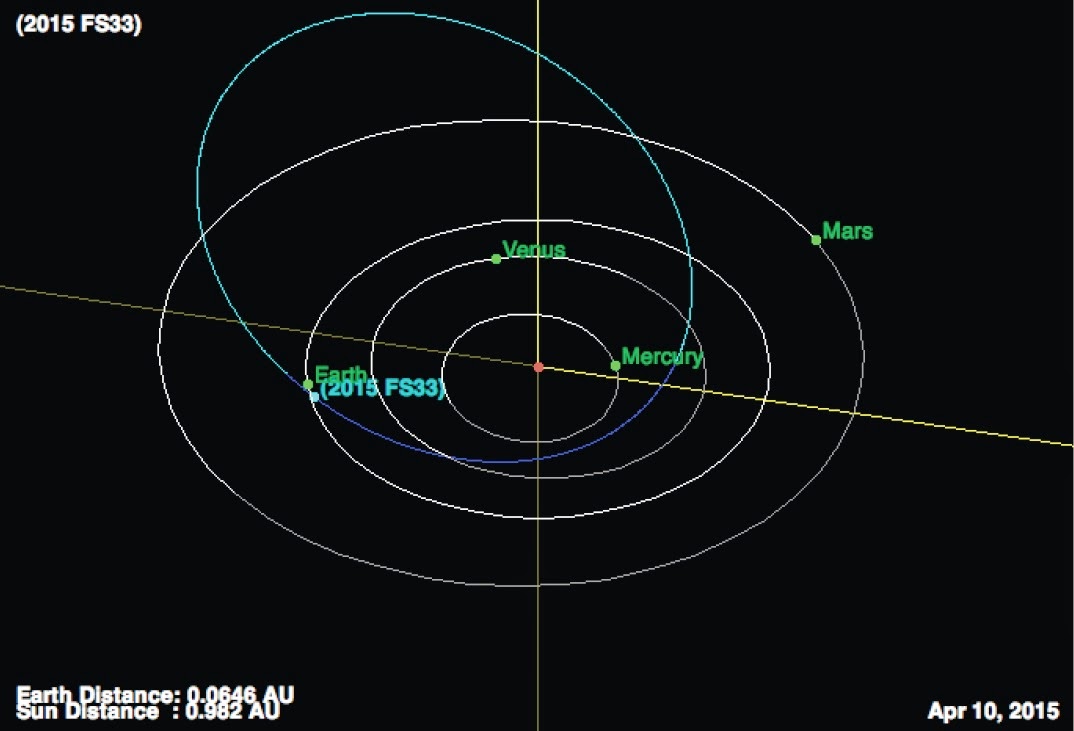Asteroid
2015 HH passed by the Earth at a distance of 4 513 000 km (11.7 times
the average distance between the Earth and the Moon, or 3.02% of the
average distance between the Earth and the Sun), slightly after 10.25 am
GMT on Tuesday 14 April 2015. There was no danger of the asteroid
hitting us, though had it done so it would have presented only a minor
threat. 2015 HH has an estimated equivalent diameter of 11-36 m (i.e.
it is estimated that a spherical object with the same volume would be
11-36 m in diameter), and an object of this size would be expected to
explode in an airburst (an explosion caused by superheating from
friction with the Earth's atmosphere, which is greater than that caused
by simply falling, due to the orbital momentum of the asteroid) in the
atmosphere between 32 and 12 km above the ground, with only fragmentary
material reaching the Earth's surface.
The calculated orbit of 2015 HH. JPL Small Body Database.
2015 HH3 was discovered on 16 April 2015 (twp days after its closest approach to the Earth) by the University of Hawaii's PANSTARRS telescope
on Mount Haleakala on Maui. The designation 2015 HH implies that it
was the eighth asteroid (asteroid H) discovered in the second half of April 2015 (period 2015 H).
2015 HH has
an 402 day orbital period and an eccentric orbit tilted at an angle of
11.5° to the plane of the Solar System, which takes it from 0.96 AU from
the Sun (i.e. 96% of the average distance at which the Earth orbits
the Sun) to 1.17 AU from the Sun
(i.e. 117% of the average distance at
which the Earth orbits the Sun). It is therefore classed as an
Apollo Group Asteroid (an asteroid that is on average further from the
Sun than the Earth, but which does get closer). This also means that
close encounters between 2015 HH and the Earth are quite common, with
the last having occurred in October 2014 next predicted for November 2014.
See also...
 Lyrid Meteor Shower to peak on 22-23 April this year. The
Lyrid Meteors will be at peak visibility between 22 and 23 April this
year, shortly after the New Moon on 19 April, which should ensure a good
display in areas with clear skies. The meteors, which appear to radiate...
Lyrid Meteor Shower to peak on 22-23 April this year. The
Lyrid Meteors will be at peak visibility between 22 and 23 April this
year, shortly after the New Moon on 19 April, which should ensure a good
display in areas with clear skies. The meteors, which appear to radiate... Asteroid 2015 FL passes the Earth. Asteroid 2015 FL passed by the Earth at a distance of 7 597
000 km (19.8 times the average distance between the Earth and the Moon,
or 5.08 % of the average distance between the Earth and the Sun), at about 0.50 am GMT on Saturday 11 April 2015. There was...
Asteroid 2015 FL passes the Earth. Asteroid 2015 FL passed by the Earth at a distance of 7 597
000 km (19.8 times the average distance between the Earth and the Moon,
or 5.08 % of the average distance between the Earth and the Sun), at about 0.50 am GMT on Saturday 11 April 2015. There was... Asteroid 2015 FS33 passes the Earth. Asteroid 2015 FS33 passed by the Earth at a distance of 9 377
000 km (24.4 times the average distance between the Earth and the Moon,
or 6.27 % of the average distance between the Earth and the Sun),
slightly before 8.00 pm GMT on Wednesday 8 April 2015. There was no
danger of...
Asteroid 2015 FS33 passes the Earth. Asteroid 2015 FS33 passed by the Earth at a distance of 9 377
000 km (24.4 times the average distance between the Earth and the Moon,
or 6.27 % of the average distance between the Earth and the Sun),
slightly before 8.00 pm GMT on Wednesday 8 April 2015. There was no
danger of...
Follow Sciency Thoughts on Facebook.

